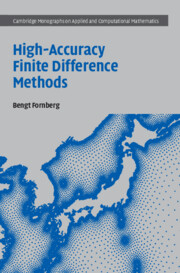Refine search
Actions for selected content:
4 results
Appendix F - Trade-offs between Accuracy Orders and Other Approximation Features
-
- Book:
- High-Accuracy Finite Difference Methods
- Published online:
- 16 May 2025
- Print publication:
- 05 June 2025, pp 194-203
-
- Chapter
- Export citation
7 - FD-based Methods for Quadrature and Infinite Sums
-
- Book:
- High-Accuracy Finite Difference Methods
- Published online:
- 16 May 2025
- Print publication:
- 05 June 2025, pp 124-140
-
- Chapter
- Export citation
8 - Fractional-Order Derivatives
-
- Book:
- High-Accuracy Finite Difference Methods
- Published online:
- 16 May 2025
- Print publication:
- 05 June 2025, pp 141-154
-
- Chapter
- Export citation

High-Accuracy Finite Difference Methods
-
- Published online:
- 16 May 2025
- Print publication:
- 05 June 2025
